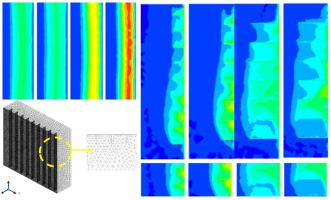Energy and Buildings ( IF 6.7 ) Pub Date : 2022-06-25 , DOI: 10.1016/j.enbuild.2022.112274 Khushbu Mankani , Hassam Nasarullah Chaudhry , John Kaiser Calautit

|
Rapidly increasing global energy demand and resulting climate change effects have enhanced the integration of renewable systems such as solar photovoltaics into the built environment. For countries with hot climates, despite vast applications and numerous technological advancements, lower efficiencies of the solar panels due to high temperature is still a major disadvantage affecting the feasibility of using photovoltaic technology. This study analyses the cooling performance of air-cooled heat sinks for the climate of Dubai, UAE, using Computation Fluid Dynamics (CFD). A stepwise optimization study was conducted to investigate the effects of varying fin spacing, baseplate thickness, fin height and fin thickness on the heat dissipation rate. Further, the elemental properties of the heat sink were studied by altering its material to aluminium. The base-model heat sink could reduce PV cell temperature by 27 °C in an ambient temperature of 42 °C. The optimized fin spacing, baseplate thickness, fin height and fin thickness of 7, 0.0025 m, 0.12 m and 0.002 m further reduced the average panel temperatures by 3.5%, 4% and 9% respectively. The use of copper as an effective heat sink material was concluded compared to aluminium that conversely increased the average panel temperature by 2% despite the use of optimized heat sink structure.
中文翻译:

用于冷却太阳能光伏板的风冷散热器优化:一项计算研究
快速增长的全球能源需求和由此产生的气候变化影响促进了太阳能光伏等可再生能源系统与建筑环境的整合。对于气候炎热的国家,尽管应用广泛且技术进步众多,但由于高温导致的太阳能电池板效率较低仍然是影响使用光伏技术可行性的主要缺点。本研究使用计算流体动力学 (CFD) 分析风冷散热器在阿联酋迪拜气候下的冷却性能。进行了逐步优化研究,以研究不同的翅片间距、基板厚度、翅片高度和翅片厚度对散热速率的影响。此外,通过将其材料更改为铝来研究散热器的元素特性。在 42 °C 的环境温度下,基本型号的散热器可以将 PV 电池温度降低 27 °C。优化后的翅片间距、底板厚度、翅片高度和翅片厚度分别为 7、0.0025 m、0.12 m 和 0.002 m,进一步将平均面板温度分别降低了 3.5%、4% 和 9%。与铝相比,使用铜作为有效的散热器材料得出了结论,尽管使用了优化的散热器结构,但铝的平均面板温度反而增加了 2%。


























 京公网安备 11010802027423号
京公网安备 11010802027423号